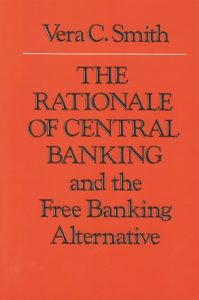Appendix
On the Working of the “Automatic Mechanism” of Credit Control
In order to make clear the argument on pp. 178-184 of the last chapter we append the following arithmetical example:
1. THE NOTE–ISSUING CASE
Assume that there are two banks (or groups of banks), A and B. Both carry on the same volume of business in the first instance. Each lends 10,000 and has 10,000 loans falling due on each settlement day.
A now increases its lending on a given day by 10,000 and all these extra loans fall due for repayment four clearing periods later, so that there are three clearings in between. Assume further (
a) that if B draws gold from A, B does not immediately increase its note issue to the extent that would bring its reserve ratio back to its former level, but only to the extent necessary to replace the notes that have not come in as usual, but have stayed out in the circulation (this merely makes it possible for it to lend currently the same amount as before); (
b) that A correspondingly reduces its outstanding note issue by the amount of the loss of gold, that is, by the amount of extra notes it has returned to it by B through the clearings. Then the total note issue outstanding of A and B together remains the same throughout the period under consideration.
| Original Position |
|
A. |
B. |
| Notes |
40,000 |
40,000 |
| Gold |
4,000 |
4,000 |
| Loan Repayments |
10,000 |
10,000 |
| A receives 5,000 of its own notes and 5,000 of |
B’s. |
| B ” ” ” “ |
A’s. |
| Notes are therefore cleared without any transfer of gold. |
| Position at First Clearing after A’s Expansion |
|
A. |
B. |
| Notes |
50,000 |
40,000 |
| Gold |
4,000 |
4,000 |
| Loan Repayments |
10,000 |
10,000 |
| A receives |
5,555 of its own notes and |
4,444 of |
B’s. |
| B “ |
4,444 “ |
5,555 “ |
A’s. |
| B draws 1,111 gold from A. |
| Second Clearing |
|
A. |
B. |
| Notes |
48,889 |
41,111 |
| Gold |
2,889 |
5,111 |
| Loan Repayments |
10,000 |
10,000 |
| A receives |
5,433 of its own notes and |
4,567 of |
B’s. |
| B “ |
4,567 “ |
5,433 “ |
A’s. |
| B draws 826 gold from A. |
| Third Clearing |
|
A. |
B. |
| Notes |
48,063 |
41,937 |
| Gold |
2,063 |
5,937 |
| Loan Repayments |
10,000 |
10,000 |
| A receives |
5,341 of its own notes and |
4,659 of |
B’s. |
| B “ |
4,659 “ |
5,341 “ |
A’s. |
| B draws 682 gold from A. |
| Fourth Clearing |
|
A. |
B. |
| Notes |
47,381 |
42,619 |
| Gold |
1,381 |
6,619 |
| Loan Repayments |
20,000 |
10,000 |
| A receives |
10,530 of its own notes and |
9,470 of |
B’s. |
| B “ |
4,735 “ |
5,265 “ |
A’s. |
B
loses 4,205 gold to A. |
| At the end of the fourth clearing the position is: |
|
A. |
B. |
| Notes |
51,586 |
38,414 |
| Gold |
5,586 |
2,414 |
2. THE DEPOSIT CREDIT CASE
We may assume in this case that the recipients of checks paid out by the borrowers of the additional 10,000 pay these checks into their banks for collection immediately. It is reasonable to suppose, unless there is an uneven distribution of deposit business between the two banks, that half of these checks will be paid into each bank.
| Original Position |
|
A. |
B. |
| Deposits |
40,000 |
40,000 |
| Cash |
4,000 |
4,000 |
| Position at First Clearing |
|
A. |
B. |
| Deposits |
50,000 |
40,000 |
| Cash |
4,000 |
4,000 |
B receives 5,000 in checks drawn on A against which there is no counterclaim of A on B; B therefore claims 5,000 in cash from A.
| The position after the first clearing is already untenable for A: |
|
A. |
B. |
| Deposits |
45,000 |
45,000 |
| Cash |
-1,000 |
8,000 + 1,000 |

